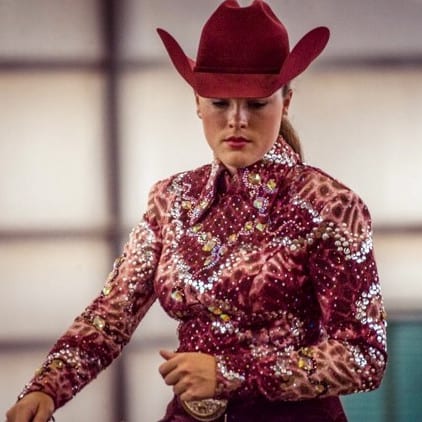You’re next. After all the months of planning, hard work and preparation, you are headed into the arena for your biggest performance of the year. You are confident in your ability to succeed and you feel the excitement of the challenge. Positioned at the cone, the only thing you can hear is your heartbeat and the announcer. You see the judge nod, and focused on the task at hand, your brain and your body are in perfect harmony. It feels like time is standing still, and you are not thinking about what you need to do, you are automatically piloting your horse through the pattern as you respond correctly to your horses movements. You are “In the Zone” and having the ride of your life.
Let’s take the same scenario, with a different outcome. Once your pattern starts, it feels like everything is in fast motion, almost like a blur. You wonder if you really saw the judge nod, or did you just go? You feel tense, and your breathing becomes rapid and shallow. You can feel your horse get a bit strong, and you sense you need to do something, but you are frozen. It’s like you left your brain in the grooming bucket, and the only time you have a conscious thought is when you are going out the gate.
While this may be a bit exaggerated, most of us have felt some type of ‘brain failure’ inside the show pen, and when it happens, it can be unnerving. But fear not! While some athletes feel that getting in the Ultimate Performance Zone is magical, you don’t need a fairy godmother to get into your ultimate performance state. Knowing and cultivating the key factors of the Ultimate Performance Zone will increase the odds that you can enter it at will.
Elements of The Ultimate Performance Zone
You just do it
When we are performing at our best, our body is automatically responding the way we have trained it to do, with no conscious mediation. When it comes to proper form, we don’t have to think about keeping our eyes up and our heels down, because through hours of practice and repetition that is how we ride. We are in unison with our equine partner, and whether it be a lead change, a spin or going over a jump, everything looks seamless. In essence, we don’t have to think about how to do a particular maneuver, we just do it, and our horse responds exactly the way we want them to.
You are in “Now”
In order to be in the Zone, you need to be in the present moment, attending to the relevant, physical things that are happening in the moment. You are not thinking about the outcome, your competitors, or if your trainer just said something to you from the rail. You are fully absorbed in the present moment, paying attention to what’s happening outside of your head. You are in “Now”.
You are up to the Challenge
One of the key factors that keeps our brain in the game is knowing that we are fully capable of getting the job done, but it isn’t so easy that we feel bored or apathetic while performing. For most of us, showing at a major show will provide enough challenge to fulfill this criteria, even if it is a walking only class.
You aren’t showing to win, you are showing because you love to show
Showing horses can be an all encompassing thing, and sometimes we lose perspective about why we do this in the first place. For most of us, this is a hobby, something we do for fun and enjoyment. Sure, it’s nice to win, however, when winning becomes the cake and not the icing, you may find that your fun and joy has been replaced with stress and frustration.
You are free of fear, thoughts and chatter
When we are performing at the top of our game, our body and brain are working together, with the proper division of labor. In essence, our brain is not occupied with fear, worry and chatter– it’s focusing on what is relevant and allowing our body to respond appropriately. Let’s say you become aware that your pace is a bit quick between the jumps, and like magic, your body makes the subtle correction needed to get the perfect distance, without you consciously thinking about it.
That’s a lot different than, “Holy Cow, I am really hauling butt out here. Did Sparky get lunged today? He sure is fresh! Oh crap! Either I need to speed up or slow down to get my distance, but I can’t decide which would be better here. The last time this happened it wasn’t pretty. I knew I wasn’t going to do well today.”
This type of conscious chatter has now taken up the brain space that was supposed to be paying attention to the “task relevant cues”, and no signals were sent to the body to do anything about it either. When we keep our attention in the present moment and not placing it on our thoughts, we perform at our best.
If you think chatter and useless thought can mess up performance, the following metaphor illustrates how fear can stop a good performer in their tracks.
In my opinion, If God was a software engineer, he or she would have designed our brain a bit differently. As we evolved, instead of replacing the old operating system with a newer version, we just slapped the new version on top of the old one, but none of the systems work very well together. So basically, we are operating on BS Versions 1.0–3.0 (the BS stands for Brain Software).
Back in the day, BS 1.0 was designed to keep us alive, and one of the key functions was to recognize threats, and prepare our body to fight or flee the scene. It’s a good system actually, kind of like a smoke alarm connected to a sprinkler system, where not only the alarm will sound, but water will pop out of the sprinkler to put the fire out. If we were out looking for berries and saw a hungry lion, the sight of the lion would sound the alarm, before we consciously become aware that the lion is there. Then our body would be flooded with chemicals that would help us run faster, fight harder, or if those weren’t really good options, we would freeze–since most animals looking for food prefer something they know is live over something that is already dead.
As we evolved, we got two more modules, BS 2.0, which deals with emotions, and then BS 3.0 which includes language, logical thinking and is also the part that allows us to remember our trail patterns and use iPhones and other gadgets.
In modern society, most of us are not worried about being attacked by a lion, however, a threat is a threat even if it is a stern look from an authority figure or we are afraid that we won’t be able to do the 270 degree turn in showmanship because we always mess it up. The alarm goes off, flooding the body with F3 Chemicals and we are now primed and ready to battle Barney the Dinosaur. But wait, there’s more! Because the fear circuitry is being used, we get tense and our breathing gets very shallow and rapid. If that isn’t enough, we don’t have access to the other parts of our brain–the parts that pay attention to the task at hand and relay that information to the body. It’s like we are riding with a brain that doesn’t know how to ride.
You have a fear buster
You may be wondering how the heck can you get from F3 and back into the Ultimate Performance Zone, and it is actually quite simple. Breathe. Slowly, from your belly. Breathing this way is the quickest way to stimulate the relaxation response which allows you to flow back into the zone.
You have a recovery strategy
Part of being in the zone is to recognize when you may be leaving it, and finding your way back. From a mental point of view, this is when you take your attention out of now, and are unable to focus on the task at hand. If you are getting clogged up with chatter, you may find that focusing on breathing nice, deep and slow (just like a great pleasure horse) or counting strides will help keep your thoughts at bay and reel you back into the present moment. With a little practice your mind will be as broke as your horse, and all it will take is a few fine adjustments to keep it in check.








